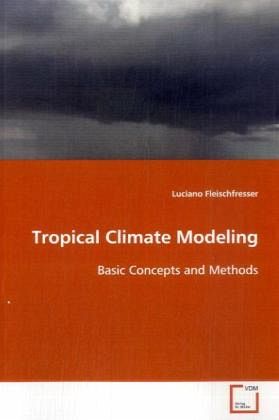
Tropical Climate Modeling
Basic Concepts and Methods
Versandkostenfrei!
Versandfertig in 6-10 Tagen
32,99 €
inkl. MwSt.

PAYBACK Punkte
16 °P sammeln!
The opportunity to model the Earth s climate is oneof the biggest challenges faced by computationalscientists and engineers. The issues range frompoorly understood physical phenomena to difficultiesimplementing subgrid processes numerically.This book is concerned with the tropical climate, the 60-degree latitude band about the Equator.It begins by establishing its energy budget, and by discussing observed atmospheric water vaporand climate model uncertainties. A criticaldiscussion of classical approaches to model cumulusclouds is given. It is argued that theserepresentations are violating some...
The opportunity to model the Earth s climate is one
of the biggest challenges faced by computational
scientists and engineers. The issues range from
poorly understood physical phenomena to difficulties
implementing subgrid processes numerically.
This book is concerned with the tropical climate,
the 60-degree latitude band about the Equator.
It begins by establishing its energy budget,
and by discussing observed atmospheric water vapor
and climate model uncertainties. A critical
discussion of classical approaches to model cumulus
clouds is given. It is argued that these
representations are violating some fundamental
physical laws. A new paradigm to represent
precipitating clouds is then proposed. It recognizes
clouds as discontinuities in the framework of
continuum mechanics. Next, results of the sensitivity
experiments are presented. Climatic feedbacks
are analyzed by perturbing the sea-surface
temperature and running themodel to steady-state.
This monograph is geared toward climate modelers,
computational fluid dynamicists, applied
mathematicians and theoretical engineers. It may also
be of interest to people with a desire to influence
the discussion on climate change.
of the biggest challenges faced by computational
scientists and engineers. The issues range from
poorly understood physical phenomena to difficulties
implementing subgrid processes numerically.
This book is concerned with the tropical climate,
the 60-degree latitude band about the Equator.
It begins by establishing its energy budget,
and by discussing observed atmospheric water vapor
and climate model uncertainties. A critical
discussion of classical approaches to model cumulus
clouds is given. It is argued that these
representations are violating some fundamental
physical laws. A new paradigm to represent
precipitating clouds is then proposed. It recognizes
clouds as discontinuities in the framework of
continuum mechanics. Next, results of the sensitivity
experiments are presented. Climatic feedbacks
are analyzed by perturbing the sea-surface
temperature and running themodel to steady-state.
This monograph is geared toward climate modelers,
computational fluid dynamicists, applied
mathematicians and theoretical engineers. It may also
be of interest to people with a desire to influence
the discussion on climate change.












